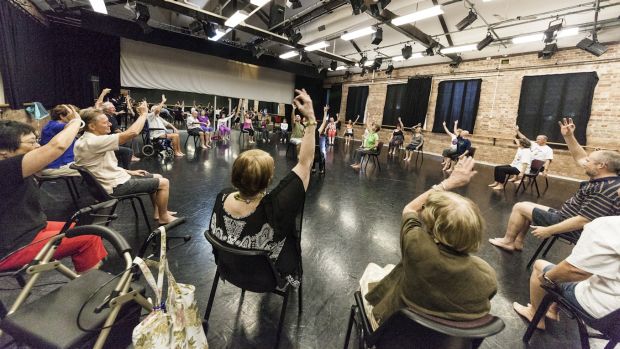
Dance for Parkinson’s has led to improvements in physical and emotional health, researchers say. Photo: Christian Tiger
Laughter may be the best medicine but it’s dancing researchers say has been proven to help people suffering from Parkinson’s disease.
The Queensland Ballet’s Dance for Parkinson’s program has received the tick of approval from researchers at two Queensland universities, participants’ walking speed, stability, posture, reach and emotional wellbeing improved.
A mixed-methods team from the University of Queensland and Queensland University of Technology followed a small number of program participants for nine months as they took part in the program.

The dancing program is hoped to help prevent people with Parkinson’s disease falling while walking. Photo: Christian Tiger
The findings didn’t surprise Stafford-based Parkinson’s sufferer Madonna Brady, who was diagnosed with the disease at just 46.
She first took part in a Dance for Parkinson’s program in Montreal and had been waiting and hoping ever since that a similar program would come to Brisbane.
The former teacher aide is still in the early stages of the disease’s unstoppable progression, but she said already felt stiff, tired and old beyond her years.

Participants take part in Dance for Parkinson’s. Photo: Christian Tiger
Further down the track the condition causes slowness of movement and the shaking it’s most commonly associated with.
Now 49, Mrs Brady said the dance program had improved her physical condition and helped her face many emotional problems.
“I felt I was drifting, we didn’t have a community or an anchor or any kindness really,” she said.

Dance for Parkinson’s participant Madonna Brady (right) with a fellow dancer. Photo: Christian Tiger
“It’s quite a devastating blow to find out you’ve got something like Parkinson’s because it’s degenerative and I didn’t know anything about it as well.
“It feels so good to be doing these things and you just think ‘that’s perfect. It’s just what we need’.
“It’s been a big improvement for me and I’m sure anyone going to the class would feel the same.”
The cross-university study followed 11 people through nine months of weekly 75-minute classes, where they took part in structured exercises and creative movement activities, learned The Nutcracker and Romeo & Juliet and watched some performances.
QUT Institute of Health and Biomedical Innovation neuroscientist Professor Graham Kerr said the sample size was small because only fifteen dancers had been available to take part at the start of the study.
The Parkinson’s Queensland president said in combination with studies from overseas, the findings were enough to convince him of the program’s worth.
“People found in themselves a really positive experience that helped their social emotional elements in terms of communication and their improving quality of life – all of those elements that were really important for them,” he said.
“So all of those, when you combine it with with their perceptions of improved quality of life, means this was a very positive effect that occurs through this program.
“Improvements in mobility and walking are very striking because they’re critical for independent living.”
UQ Professor Sandy Brauer said researchers were surprised by the changes to some people, particularly some particularly enthusiastic older men.
“A main finding was the improvement in the ability of participants to walk and perform another function at the same time, which is often difficult for people with Parkinson’s disease,” she said.
“Falls are a major threat to the 80,000 Australians with Parkinson’s disease, leading to injuries, dependency and institutionalisation, so it’s a promising step to improve walking which could reduce the risk of falls.”
QB’s program is the only Dance for Parkinson’s program in Australia to be run by a professional dance organisation.
QB education manager said she was “exceptionally proud” of the program and was hoping to expand it into regional Queensland.
